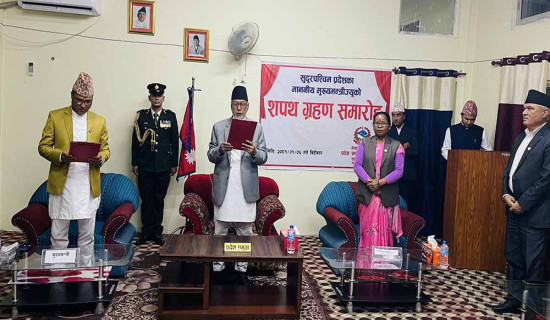- Friday, 19 April 2024
Trade With Caution
After the adaptation of liberal foreign trade policy, Nepal's foreign trade is expanding continuously. Currently, the country makes annual foreign trade of around Rs. 2,120 billion with more than 200 countries of the world. Despite the increase in the volume of foreign trade and number of trading partners, the country has failed to enjoy the benefits of foreign trade as the proportion of the export to the total trade volume is very nominal. In last one decade, the country's trade deficit is widening continuously posing a threat to external sector instability. As per the annual data published by the Nepal Rastra Bank, the volume of Nepal's export stood only at Rs. 200 billion in fiscal year 2021/22 as contrary to the import of Rs. 1920 billion.
In spite of the increasing trade deficit, the country was enjoying the balance of payment surplus until last fiscal year mostly due to the contribution of continuously increased remittance income. But from the last fiscal year, the country is reeling from the spiral of balance of payment deficits and depleting foreign exchange reserves caused by increased trade deficit in line with sluggish remittance inflow. In response to the possible threat of economic crisis that may create from continuous balance of payment deficit and decrease in foreign currency reserve, the government and the central bank have taken various measures to discourage import of luxurious items. The impact of such policy measures adopted by the government has started to appear recently.
According to a news report published in this daily on Monday, the country's foreign trade has decreased by 15.70 per cent to Rs. 302.28 billion during the first two months of the current fiscal year 2022/23. The decline in trade volume is contributed by the fall in both exports and imports. During the review period, imports and exports have decreased by 13.01 per cent and 44.03 per cent respectively. As per the statistics provided by the Department of Customs, the country's trade deficit has gone down by 9.45 per cent point to Rs. 244.91 billion during the review period as compared to the same period of previous year. Besides, the remittance income of the country has also shown increment in recent months. It has increased by 20.3 per cent during the first month of the current fiscal year.
Though there are some positive signs appearing in the economic fronts, prompt cautions are still needed to prevent the economy from facing possible economic crisis. As trade deficit and balance of payment deficits are still high, and remittance income is not growing as expected, the country should continue the policy of discouraging luxurious imports. Besides, the government should focus on encouraging domestic production of goods and services that increase exports and substitute imports. A policy to curtail consumption of petroleum product by encouraging the use of electricity will also be supportive to correct the trade deficit problem.
At the meantime, the decrease in the proportion of import of capital goods in the total imports is also the matter of worries. The proportion of the capital goods on total import has decreased to 8.7 per cent in the first month of current fiscal year from 11.5 per cent a year ago. Such a decline in the import of capital goods is likely to hamper future productions of the country. To address this problem, the government and the central bank should solve the problem created by liquidity crisis in the financial sector. Solution to the liquidity problem will also help to encourage domestic production to increase exports and substitute imports.

















